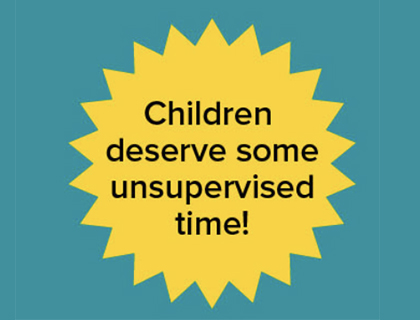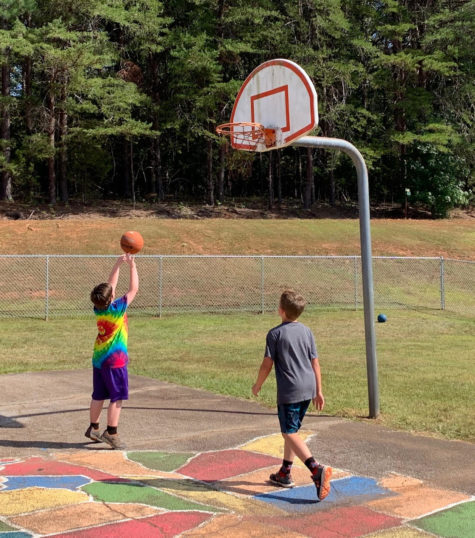The age that kids start playing — walking, biking, frolicking outside — should be up to the parents. But that’s not always the case.
A few years back, after the first Reasonable Childhood Independence law passed in Utah – hooray! – we received a query from a lawmaker. He said he wanted his state to pass a similar law assuring parents that allowing their kids to play outside, stay home alone, walk to school, etc., would not be mistaken for neglect. And so, he’d drafted a bill:
Parents are not to be investigated or accused of neglect simply for letting their children, ages 10 and up, engage in independent childhood activities.
He expected us to be excited!
We were not.
In fact, as we gently explained, this was a law we could not endorse.
The “neglect” laws too often underestimate kids — and over-empower the authorities.
In the years we’ve been advocating on this issue, we often encounter well-intended people like that lawmaker who believe the right to childhood independence should be granted. But only to children above a certain age. Usually, the suggested age is much higher than we know many children could manage.
Because we firmly believe that parents know their own children best, and because the circumstances for giving independence vary wildly by the activity, the geography, the child’s preparation, etc., etc. AND because all these parameters can’t be laid out in a neat set of boundaries, we oppose legislating age limits in both laws and policies.
5 and 6-year-olds are ready for a LOT!
Now — guidance? Helpful suggestions? Sure! A list of ages explaining, in general, the ages kids are physically and cognitively capable of doing things on their own? We’re all for it. That’s why Let Grow’s legal consultant, Diane Redleaf, joined with two professors of psychology to co-author this 2023 article in The Journal of Social Policy on what age children are developmentally ready for some unsupervised activities. After a survey of ethnographic, pediatric, and psychological literature, they found that, “most children benefit from some degree of independence by the time they are 5–6 years old.”
Good to know, right? Guidance can be illuminating. But that’s not putting actual age limits into law.
Why we are against age limits in law or policy:
- They inhibit both parents and child welfare professionals’ use of judgment.
- Age limits could too easily become a shorthand for an overtaxed child welfare professional. They can also be a way for a more distant decisionmaker (such as a judge, who only gets second- or third-hand information about the child) to insert their personal opinions on child upbringing in place of the parents’.
- Age limits will force child welfare professionals to expend unnecessary time and resources in trying to make exceptions to a general rule. When a child who is clearly safe is nonetheless the subject of a hotline call and is below the age limit set for that activity.
- They will open child welfare professionals to charges of unequal application of the law.
- Age limits are arbitrary. To overgeneralize the point (of course, there are exceptions!), a 9-year-old who is an only child is likely to have had quite different experiences from a 9-year-old with four younger siblings.
- An age limit of, say, 10, means that a 10-year-old could play outside, but not with her 6-year-old brother if the law says 6-year-olds must always be supervised by an adult.
- At the same time, an age limit could, unfortunately, give a parent who truly is neglectful a free pass if their child was at or above the age limit but lacked sufficient maturity for the activity the parent allowed.
- Across the 50 states, there is no consistency in age limits. They range from age 6 (in Kansas) to states like Michigan, holding that children can’t be alone before the age of 11—on pain of criminal and neglect prosecutions for their parents. Are kids in Kansas so much more capable than kids in Michigan?
Age limits don’t solve problems, they create them.
Any legal age limit for childhood independence is likely to create a problem of over-including children who are capable of independence and possibly under-including children who are not yet able to exercise independence.
Let Grow sees age limit laws and regulations as triple-edged swords that can harm parents, hinder child welfare professionals, and stunt kids who are ready for some independence.
For more on this issue, please visit the Let Grow Advocacy Toolkit, scroll down and click on “The Case Against Age Limits.” You will find a list of all 50 states’ age limits (at least as far as these can be determined) at the bottom. Meantime, if you would like to help make sure your state supports childhood independence, please click on the “Get Involved” button on our State Laws page!




1 Comment
When I was five…
— Every day I walked to kindergarten all by myself, and crossed a park and two moderately busy streets.
— I was sent to buy a box of cake flour at the little store, all by myself. I had to cross a busy four-lane street (at the light, which I already knew how to do). And brought home the correct change. (Actually, I had to go twice, because my mom didn’t send along enough coins the first time.) I remember this so clearly because the flour was for my birthday cake (so I must have just turned five).
In 1960, this was no big deal.
What if I’d been prohibited from this til I turned ten? I’d probably never have learned how, having missed the window where growth experiences are so critical.